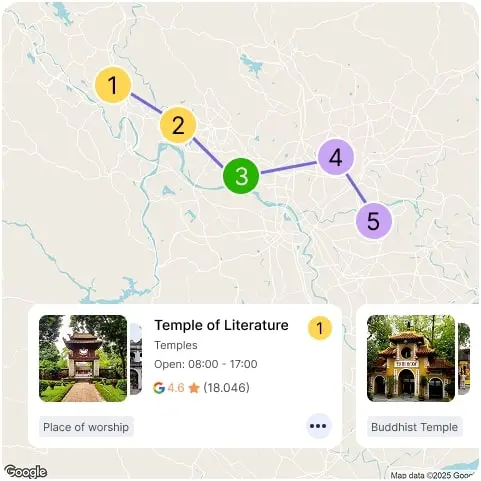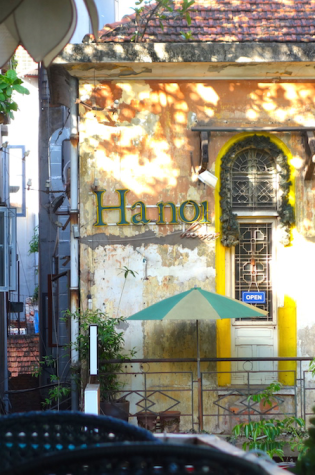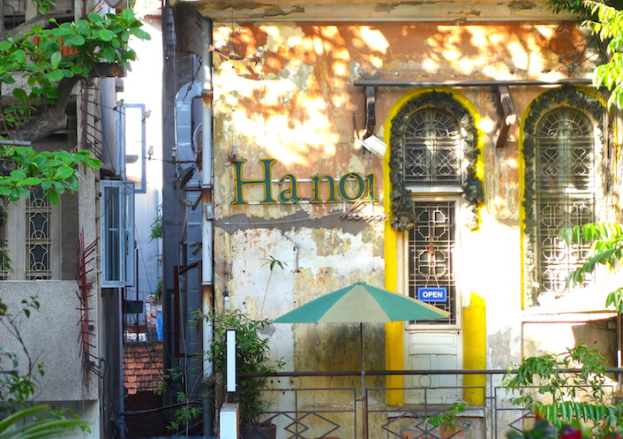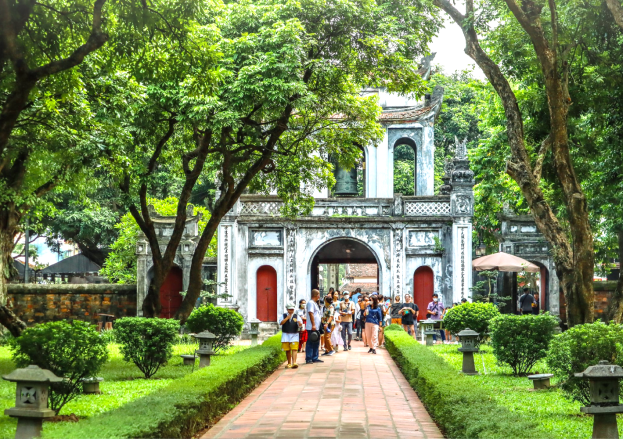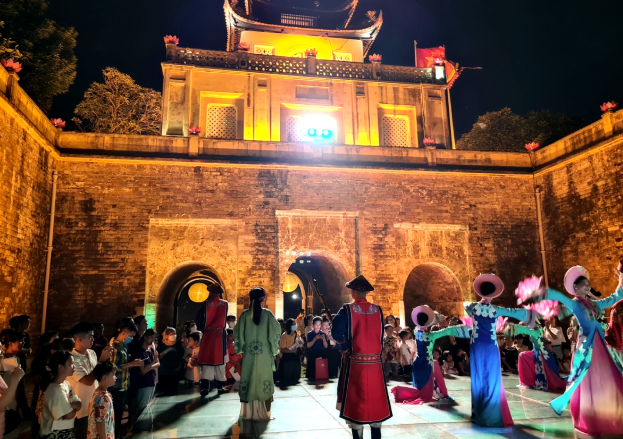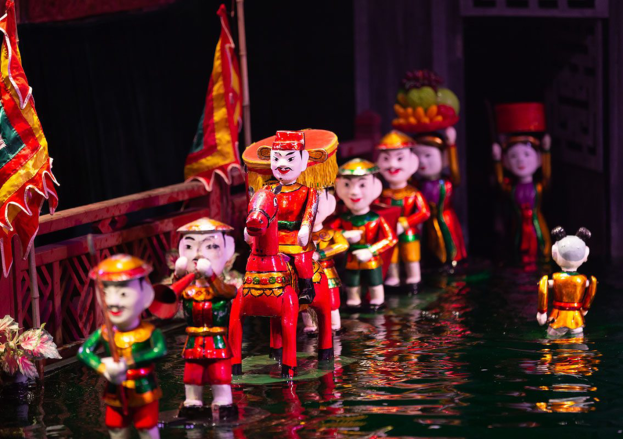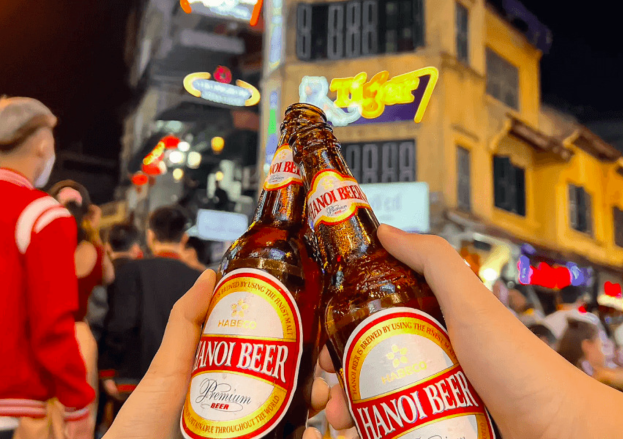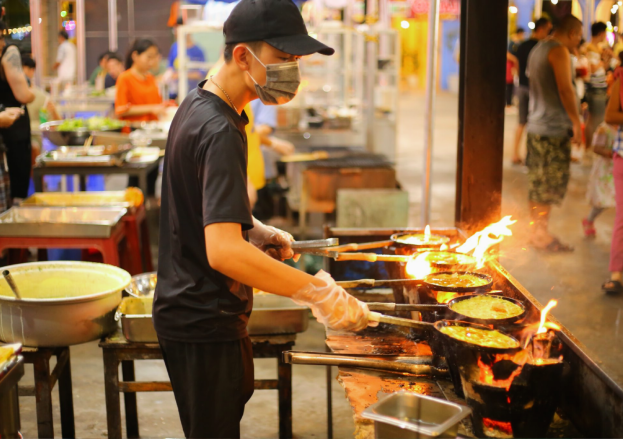
Craft Villages
Explore the traditional craft villages of Vietnam, where the cultural heritage and artisanal skills have been preserved across generations. Here, visitors can learn about, experience, and purchase unique handcrafted products, from pottery and silk weaving to bamboo and rattan crafts.
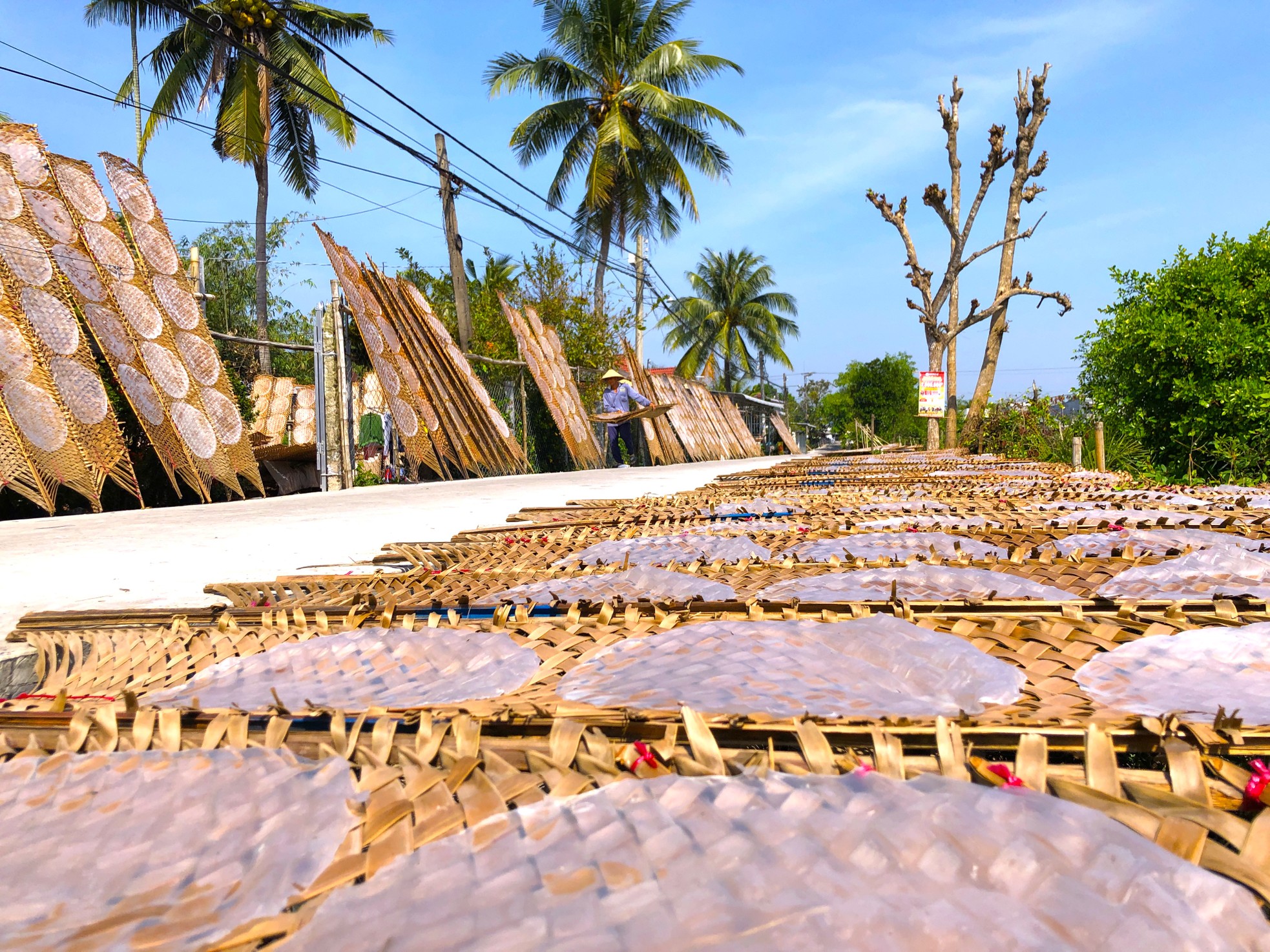
Discover the secrets of making traditional Trang Bang Rice Paper
28 Aug, 2025
Where is Trang Bang Rice Paper Village? Trang Bang Rice Paper Village is located along National Highway 22, in Loc Du neighborhood, Trang Bang town, about 40 km from the center of Tay Ninh city. For generations, this craft village has been passed down and become a traditional hallmark of Tay Ninh. Every Lunar New Year season, rice paper kilns burn through the night to meet the growing demand, and even after the holiday, the village remains bustling and lively. Each artisan in the village has often devoted decades to the craft. Under their skillful hands, hundreds of dew-dried rice papers are produced daily. According to senior artisans, the rice paper-making tradition was inherited from ancestors who migrated from the Ngu Quang region of Binh Dinh to Tay Ninh in the 18th century. Initially, the village produced only grilled rice paper and soaked rice paper, but over time, many variations were developed, among which dew-dried rice paper became the most distinctive. The sunny days and dewy nights of Trang Bang, combined with traditional techniques, contribute to the perfection of each rice paper. The Origins of Dew-Dried Rice Paper in Trang Bang There are many tales about how dew-dried rice paper originated. One story tells of a young man who left a stack of grilled rice paper outside in the afternoon; overnight, the dew softened the paper. Reluctant to waste it, he ate it and found it delicious. Another story tells of a girl selling grilled rice paper who didn’t finish her batch; she left them outside, and overnight dew softened the paper. Curious, she tried it and found it tasty, which eventually led to the creation of dew-dried rice paper. Regardless of the version, the combination of sunny days, dewy nights, and generational craftsmanship created the unique, famous tradition of Trang Bang Rice Paper Village. The Process of Making Dew-Dried Rice Paper Selecting Ingredients and Spreading the Batter According to the artisans, the most important step for high-quality rice paper is selecting premium rice, typically Mien village rice. The rice is washed thoroughly, soaked for two days, with a pinch of salt added for every 5 kg of rice, and the water changed continuously before grinding into a fine batter. To make the rice paper soft, white, chewy, and flavorful, a small amount of salt is added to the batter. When spreading the batter, the artisan must be skilled to ensure the batter spreads evenly without tearing. Trang Bang dew-dried rice paper is made with two layers of batter tightly stacked, unlike ordinary rice paper made with a single layer. Once cooked, the rice paper is placed on a bamboo tray and left under gentle sunlight for 30 minutes to 1 hour, depending on the weather. When the paper is slightly dry and lifting from the tray, it is removed and lightly grilled over fire. Grilling and Dew-Drying the Rice Paper While selecting ingredients and spreading the batter determines the flavor, grilling and dew-drying make Trang Bang rice paper truly distinctive. Grilling: The kiln is simple, consisting of a round-bottomed pot tilted sideways. Peanut shells are used as fuel to keep the fire moderate, ensuring even cooking. The griller must be meticulous and quick, constantly turning the rice paper to ensure even expansion without separating the layers. Dew-Drying: The grilled rice paper is placed outside to dew-dry around 9–10 PM or 2–3 AM. The night dew softens the paper just enough. The rice papers are then stacked, placed in bags, and tightly sealed to prevent air from hardening them. The most challenging aspect of the craft is sitting for hours by the red-hot kiln, staying up late and waking early to catch enough dew for perfect rice paper. Each dew-dried rice paper embodies the essence of nature and the artisan’s hard work, making it a famous specialty of Tay Ninh. A visit to Trang Bang Rice Paper Village is more than tasting a specialty—it’s witnessing dedication passed through generations. Each dew-dried rice paper reflects the harmony of sun, dew, and artisan skill, making it a true culinary treasure of Tay Ninh.
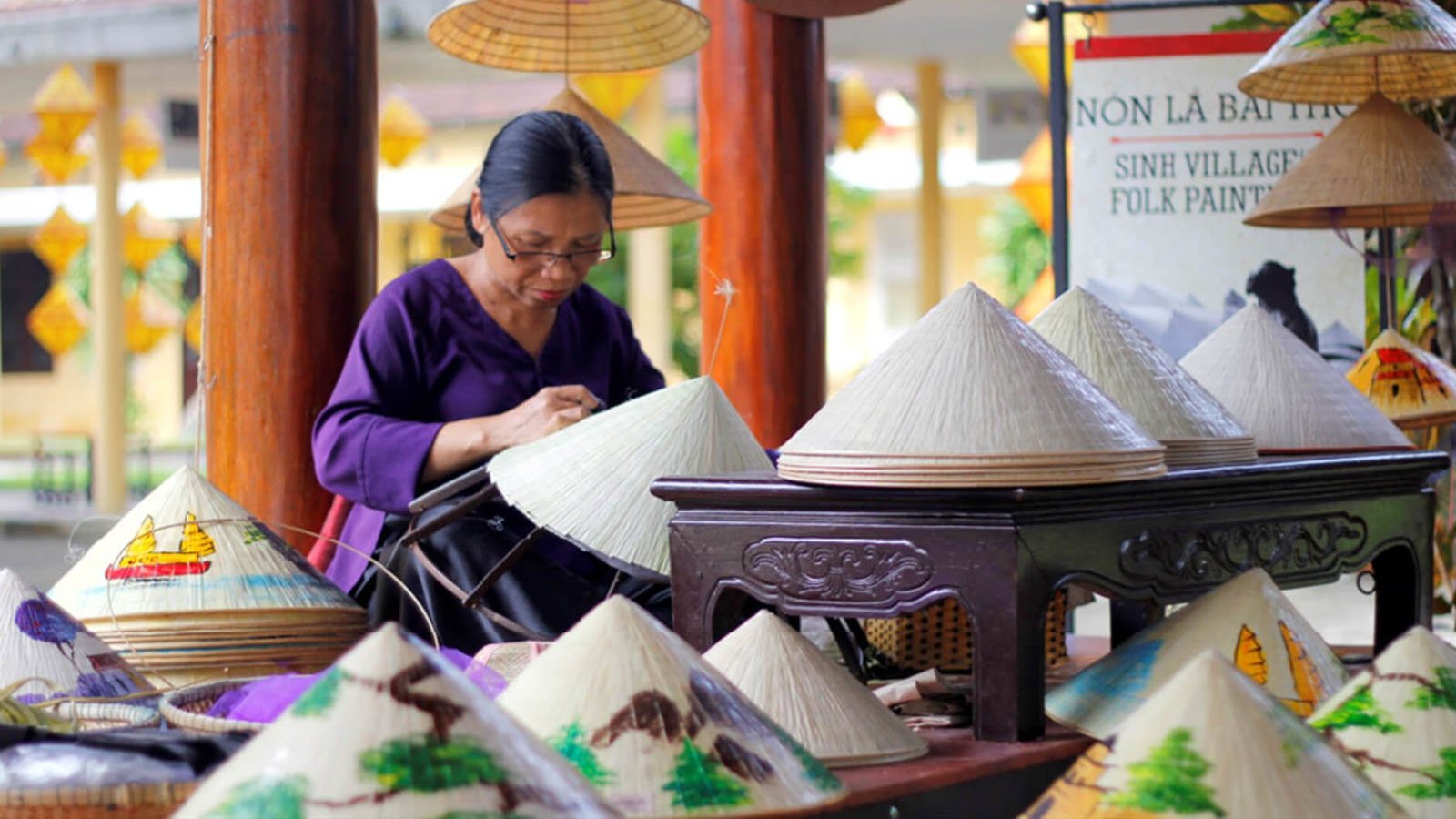
Visiting the Tay Ho craft village in Hue to admire the traditional Vietnamese conical hat-making
28 Aug, 2025
Tay Ho Craft Village – The Homeland of Hue Poetry Conical Hats Address: Phu Ho Commune, Phu Vang District, 12 km from Hue city center, along the Nhu Y River Tay Ho Craft Village is one of Hue’s famous traditional craft villages, established hundreds of years ago. This village is particularly renowned for poetry conical hats, which first appeared around the late 1950s, reflecting the cultural and artistic identity of Hue. Visitors to Tay Ho will have the opportunity to admire the peaceful and poetic charm of Hue countryside, with vast rice fields, simple rustic scenery, and a tranquil, lyrical atmosphere. Here, they can also explore the stages of creating these beautiful poetry conical hats. Almost every household in Tay Ho is involved in hat-making, and visitors can see fresh leaves from the bo quy diep tree, coconut leaves, or goi leaves being dried in front of homes or on open ground, forming a dreamy golden color. The craft village is always lively. Regardless of summer or winter, villagers work on hat-making year-round, bustling with buyers and sellers, while skilled artisans diligently stitch each hat. What impresses visitors most is the warm hospitality of Tay Ho people, who welcome guests cheerfully, offer refreshments, and proudly introduce the poetry conical hats of their village. Experience Visiting and Interacting with Artisans Visitors can not only tour the village but also chat and learn from experienced artisans about poetry conical hats, hearing about their passion, love, and pride for this traditional craft. More notably, guests have the chance to personally try making poetry conical hats, creating their own personalized designs. The process of making a Hue conical hat is meticulous, including selecting leaves, splitting bamboo, ironing the leaves, and stitching the hat together. According to long-time artisans, the most challenging step is stitching the hat, usually performed by skillful women or young girls, requiring extreme precision and patience. The Legend Behind the Poetry Conical Hats The story of the poetry conical hats of Tay Ho began around 1959–1960. Artisan Bui Quang Bac, a long-time lover of conical hats, had the idea to press poetic verses between two layers of leaves, making the hat not only more beautiful but also conveying meaningful messages. The very first verses pressed onto Tay Ho hats were: "Ai ra xứ Huế mộng mơ. Mua về chiếc nón bài thơ làm quà." ("Anyone visiting dreamy Hue. Buy a poetry conical hat as a gift.") Initially, poetry conical hats were made to gift relatives or esteemed guests. After gaining popularity and receiving many orders, the villagers of Tay Ho began producing them in larger quantities, establishing the well-known brand of poetry conical hats still recognized today. Tay Ho Craft Village is not only a cultural tourism destination but also a place that preserves Hue’s distinctive traditional handicraft art. Here, visitors can admire the rustic beauty of the village, experience the meticulous process of hat-making, and understand the artisans’ love, dedication, and pride for their craft. The poetry conical hats are not merely souvenirs but a refined and romantic cultural symbol of Hue.

Visit Tuyet Diem salt village – The traditional labor beauty of Phu Yen
28 Aug, 2025
Tuyet Diem Salt Village – The Traditional Labor Beauty of Phu Yen Address: An Ninh Tay Commune, Song Cau Town, Phu Yen Province, Vietnam Tuyet Diem Salt Village, peacefully nestled at the foot of the legendary Cu Mong Pass, is a destination that highlights the labor and culture of the people of Phu Yen. Located about 50 km north of Tuy Hoa city center, it is convenient for visitors exploring the “land of golden flowers and green grass.” The village has a history dating back to the 18th century, closely tied to the lives of local coastal residents. The name Tuyet Diem, meaning “salt as white as snow,” not only describes the purity of the salt but also emphasizes the superior quality of the specialty salt from Song Cau, Phu Yen. Unlike other salt-producing regions where harvested salt is the final product, the people of Tuyet Diem further process their salt into more refined and unique products. The Beauty of Tuyet Diem Salt Village The village’s charm lies not only in its vast white salt fields but also in the image of diligent salt farmers working under the scorching sun. This scene creates both beautiful and meaningful snapshots of the labor life of the coastal people, leaving visitors both impressed and curious about this traditional craft. Discover the “Salty Beauty” of Tuyet Diem Explore the salt fields One of the most memorable experiences in Tuyet Diem is walking through the endless white salt fields, stretching like giant mirrors reflecting the deep blue sky. Under the blazing sun, the sparkling salt crystals create a dazzling and almost magical scene. Visitors can stroll along narrow paths between the fields, feel the heat of the ground beneath their feet, and breathe in the fresh, salty air. It’s also an opportunity to interact with local salt farmers, learn about traditional salt-making, and capture unique photos with the pristine white salt fields as the backdrop. Learn the traditional salt-making process At Tuyet Diem, visitors can experience an immersive journey into the traditional, labor-intensive salt-making process—a craft that local people take pride in preserving. Step 1: Filling the ponds with seawater Farmers lead seawater into ponds and leave it under the sun for 4–5 days until the salt crystallizes. Step 2: Harvesting and piling the salt Each grain of salt is carefully raked and piled into mounds before being carried to the collection area. This work requires precision and endurance under the scorching sun, yet locals continue to uphold the craft as a way to preserve tradition. Step 3: Sifting and refining the salt After harvesting, the salt is placed in ovens and boiled continuously for 24 hours. Skilled workers carefully distribute the heat evenly by spreading embers over the surface multiple times. Once the salt is “cooked,” it is cooled and sifted by hand to collect the finest, fragrant powder. This meticulous and unique process sets Tuyet Diem salt apart, making it more renowned than salts from other regions. Tuyet Diem Salt Village is not only a source of high-quality salt but also a heritage of traditional labor in Phu Yen. Visiting the village, travelers can admire the pristine white salt fields, experience traditional salt-making, and appreciate the hardworking, resilient spirit of the local farmers. It is truly a destination rich in cultural value that offers unforgettable experiences for every visitor.
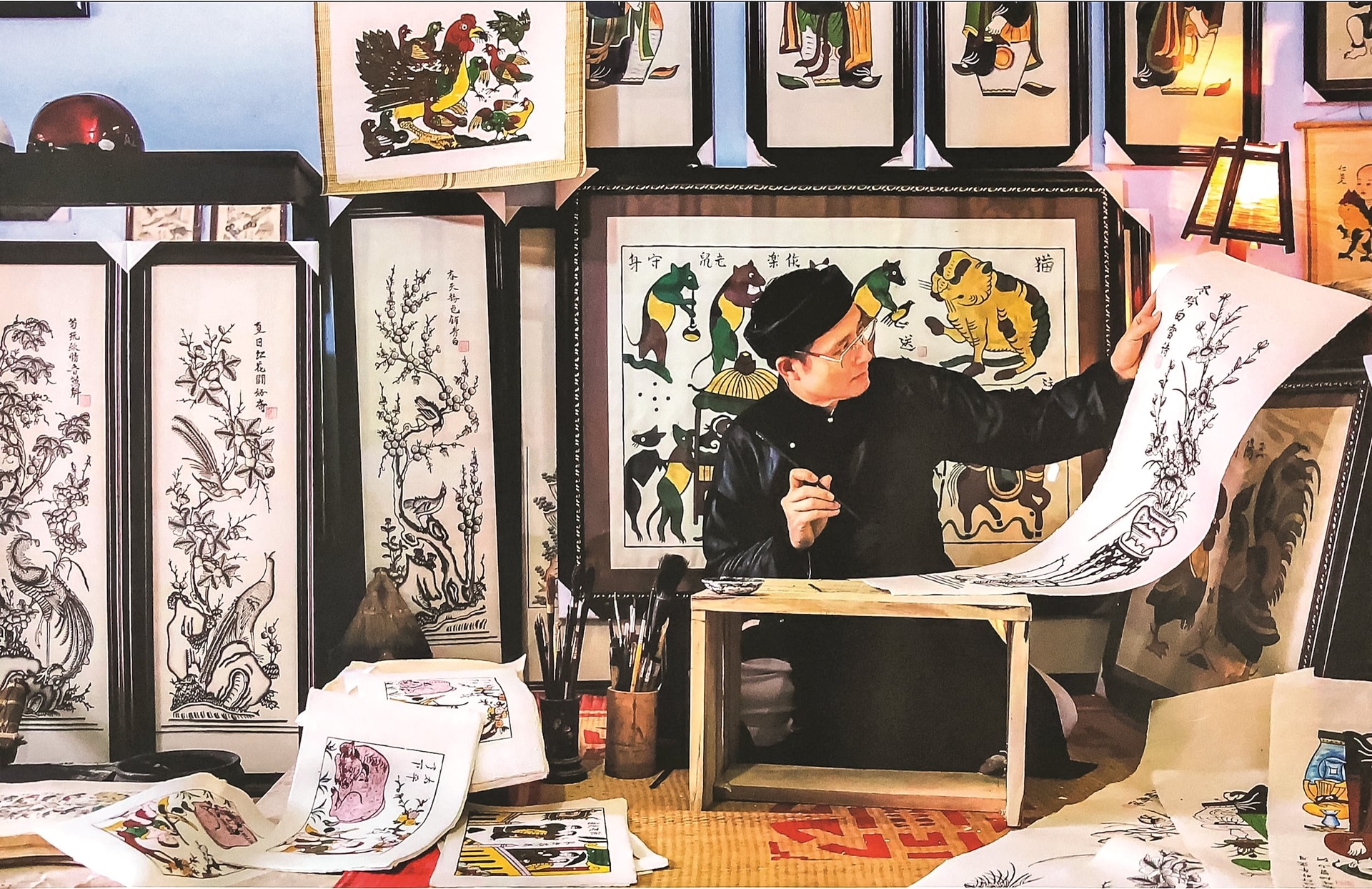
Uncover Dong Ho painting village: The timeless cultural beauty of Kinh Bac
28 Aug, 2025
Where is Dong Ho Painting Village? Where is Dong Ho Painting Village or which province Dong Ho Painting Village is in is a question that many tourists are interested in when learning about this famous tourist destination. This folk painting village is located on the banks of Duong River, in Song Ho commune, Thuan Thanh district, Bac Ninh province, about 16km from Bac Ninh city center. Because it is not far from Hanoi, about 35km, this place is also called Dong Ho Hanoi painting village. History of Dong Ho painting village Visiting here, tourists will be introduced to the history of Dong Ho painting village by artisans. Starting in the 17th century in Dong Ho village, Song Ho commune, Thuan Thanh district, Bac Ninh province, up to now, the painting profession here has been around for more than 400 years. According to historical records, around 1945, Dong Ho village had 17 families, all of these families made paintings. Having gone through the ups and downs of history, Dong Ho village currently has two families practicing painting: the families of artisans Nguyen Dang Che and Nguyen Huu Sam. What is special about Dong Ho Bac Ninh folk paintings? Ho village paintings are loved because they show familiar themes, associated with the image of the countryside and the simple daily life of Vietnamese people. The people of Ho village know how to filter and apply natural materials to create traditional colors that are both fresh and highly durable: indigo from the Cham tree, crimson from the bark of the Van tree, black from Bamboo leaf ash or Chiffon ash,... Unique paintings are printed on Do paper. This type of paper is handcrafted from the Do tree growing in the forest. The paper background is often coated with a layer of resin or a layer of paste mixed with a little powder from Scallop shells to create a sparkling color. Therefore, Do paper is also called Diep paper. To make vivid paintings, craftsmen need printing boards. There are two types of engraved and printed boards: color printed boards and sharp printed boards. Printed boards are usually made from squid wood or thi wood. Printing board engraving tools are chisels, also known as ticks, made from hard steel. Colored printed boards are made from fatwood because they have a higher ability to retain color. The process of making Dong Ho folk paintings includes the following steps: Step 1: Prepare Do paper: After picking it from the forest, the worker will pound it, sift it into fine powder and process it into Do paper. Step 2: Printing the painting: The artist prints colors on the painting to create shapes. Normally, a painting requires 5 engravings, printed in 5 times. Step 3: Drying the painting: After printing, the painting needs to dry to prevent smudging and color durability. Discover the beauty of Dong Ho painting village in Bac Ninh Dong Ho Painting Village is one of the famous tourist destinations near Hanoi. Coming here, visitors will experience many interesting activities, contributing to making the trip to Dong Ho painting village more attractive and memorable. Some activities that visitors should not miss when coming to Dong Ho painting village include: Check-in to Dong Ho painting craft village Ho village's paintings are realistic and vivid, expressing a meaningful message. Visiting here, you can check-in with unique paintings created by the people of Ho village. Learn how to make paintings following the instructions of artist Dong Ho Not only admiring Dong Ho paintings, visitors can also directly participate in the painting process to better understand the unique features of this traditional craft. Through the guidance of artisans at Dong Ho painting village, Bac Ninh, you can absolutely create a vivid and beautiful painting. Participate in the interesting Dong Ho painting exhibition More than 100 artifacts and paintings from the Dong Ho painting craft village are displayed at the Vietnam Fine Arts Museum. Coming here, you can admire up close the paintings that have made the Dong Ho painting brand such as Mouse Wedding, Vinh Quy Bai To, Rose Rooster, Vinh Hoa of Wealth, Buffalo Shepherd Playing the Flute... Watch the Dong Ho folk painting festival in Bac Ninh Dong Ho Village Festival takes place from March 14 to 16 of the lunar calendar every year, attracting many tourists with unique folk paintings. This is one of the unique festivals, suitable for spring tourists. Meet the elite artisans of Dong Ho painting village Visiting Dong Ho painting village, tourists can also meet elite artisans such as Artisan Nguyen Huu Sam and Artisan Nguyen Dang Che to learn about the history and discover the uniqueness of traditional crafts here. A trip to Dong Ho Painting Village is more than sightseeing—it is an immersive journey into Vietnam’s rich cultural legacy. From hands-on painting experiences to witnessing centuries-old techniques, visitors leave with a deeper appreciation for the artistry, history, and timeless beauty that define this remarkable village.
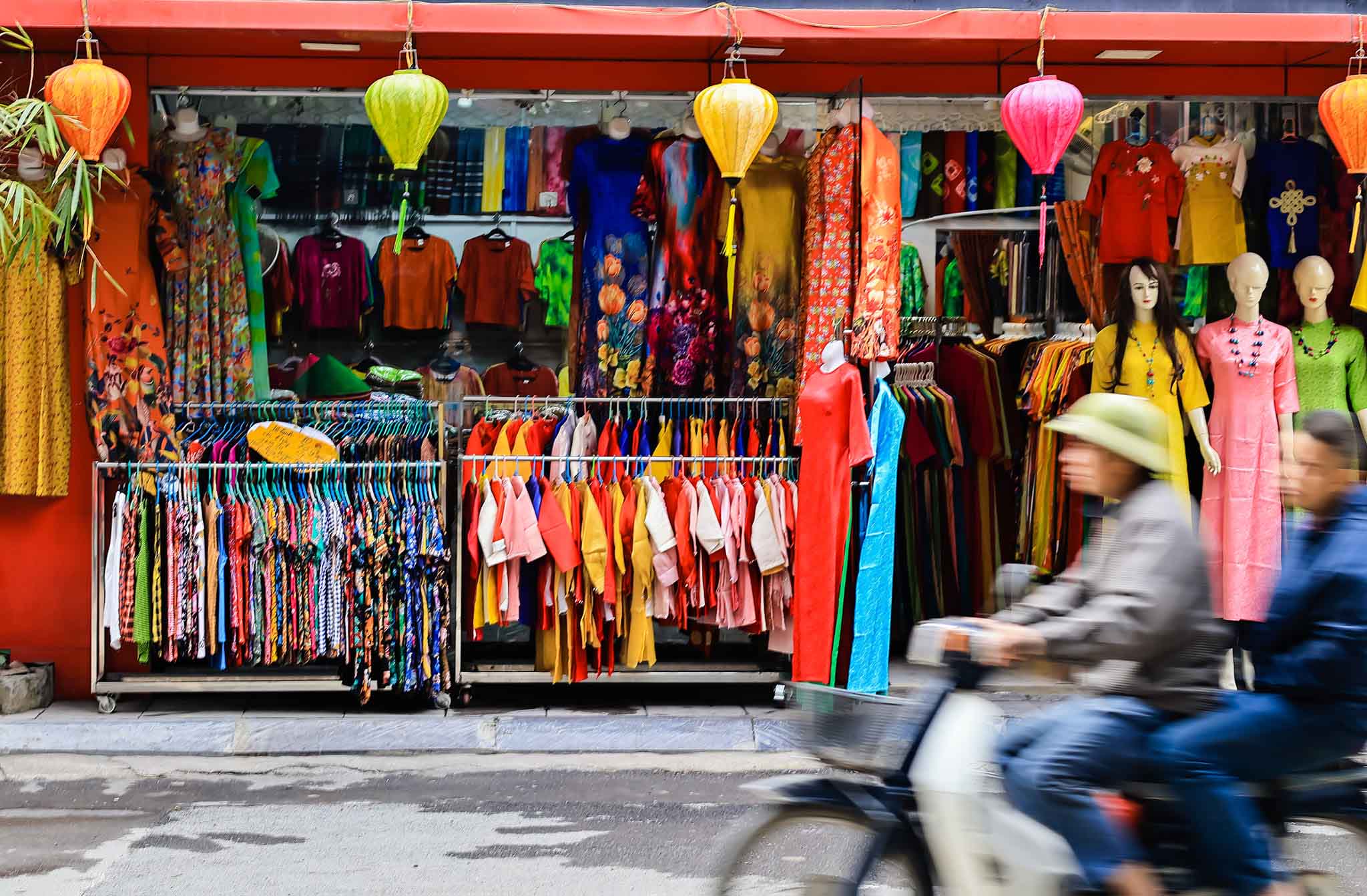
Learn about Vietnamese weaving at Van Phuc Silk Village
28 Aug, 2025
History of Van Phuc Silk Village Address: Van Phuc Ward, Ha Dong District, Hanoi When exploring the bustling city of Hanoi, don’t miss Van Phuc Silk Village—a place that preserves the essence of Vietnamese culture through its famous traditional craft, celebrated in poetry, music, and art. Located about 10 km from central Hanoi, Van Phuc Silk Village (also known as Ha Dong Silk Village) attracts visitors not only with its renowned silk weaving but also with its immense tourism potential. In the past, Van Phuc was called Van Bao, but due to the taboo of the Nguyen dynasty, its name was changed to Van Phuc. In 1931, Van Phuc silk was first introduced to the international market at the Marseille Fair, where the French praised it as the most exquisite product of Indochina. By 1958, Van Phuc silk was exported to Eastern European countries, and today it is still highly appreciated in many countries around the world. Over generations, Van Phuc silk has retained its traditional beauty and continues to lead the weaving industry in Vietnam. The silk from Van Phuc is known for its elegance and durability. The patterns are diverse, symmetrically arranged, simple yet striking, and always convey a sense of openness and decisiveness. Regarded as a symbol of Ha Dong land, the village gate welcomes visitors and stands out along To Huu Street, easily recognizable. The gate is constructed simply with red bricks but remains strong and solid. To the left of the main gate is a large stone stele with the village name elegantly inscribed in calligraphy. Traditionally, the village gate was considered a protective barrier for the community and a welcoming landmark for those returning to their roots. The Cradle of Vietnam’s Brocade and Silk Craft When it comes to silk weaving, no one can ignore the legendary Van Phuc Silk Village. Its fame is such that it has been immortalized in poetry and has become a cultural specialty and one of Hanoi’s unique attractions. Van Phuc Silk Village represents a harmonious blend of tradition and modernity. Today, the village has more than 800 households engaged in the craft. Many families still maintain the old handlooms passed down from their ancestors, alongside more modern mechanical looms. Visiting the village feels like stepping into another world, filled with a timeless, simple, and peaceful atmosphere. Visitors can admire symbols of a golden era, such as banyan trees, village wells, communal yards, and traditional markets. Inside the village, Van Phuc Silk Market showcases, promotes, and sells products to tourists. Each shop has its own display style, yet all share the common trait of vibrant, lively colors. Shelves are filled with diverse products, from scarves, shirts, trousers, and ao dai (traditional long dresses), to decorative items made from silk. For the people of Van Phuc, every silk piece represents the entire process—from mulberry cultivation, silkworm rearing, cocoon harvesting, spinning, and weaving to dyeing. They view it as the essence of nature and a testament to the skill and dedication of the artisans. Bringing home this precious specialty and gifting it to respected elders carries deep cultural meaning. The occupational culture of Van Phuc’s weaving village is deeply ingrained in the values and manners of Vietnamese people. Discover the Essence of Vietnamese Silk Creating a traditional silk piece requires multiple stages and tremendous effort. While the steps may sound simple, achieving mastery and producing high-quality silk demands devotion—from reeling cocoons, spinning silk, preparing and connecting the loom, weaving, to dyeing. At every stage, artisans must be extremely careful, supervising the process 24/7, even when machines are in operation. In the past, silk was mainly used for making traditional blouses and shirts, but today it is also used for modern suits, dresses, and contemporary fashion. The primary material remains silk, but artisans often combine it with other fabrics to create new product lines that are competitive and meet market demand. Creative items include scarves, bags, blankets, and other silk products, offering visitors a wide variety to choose from. Visiting the village is an unmissable experience in Hanoi. You can witness the entire silk production process carried out by the skillful hands of the artisans. For those who want a more in-depth understanding, the workshop of artisan Trieu Van Mao is a must-visit location. Here, Van Phuc silk in a wide range of colors and designs is neatly displayed on shelves, catering to the preferences of various customers. A Photogenic Destination: Antique Yet Novel First introduced in 2019, Van Phuc’s “Umbrella Street” quickly attracted the attention of many young visitors. This approximately 100-meter street leads into the heart of the traditional Van Phuc Silk Village. From the main gate to the village center, thousands of colorful umbrellas hang overhead, creating a spectacular visual display. The shimmering umbrellas cover the street, flanked by rows of silk shops that form a romantic backdrop perfect for photos. Umbrella Street in Van Phuc has become a brand-new tourist attraction in Hanoi, drawing both domestic and international visitors. It offers the dual delight of taking beautiful photos while enjoying the feeling of walking beneath a canopy of vibrant silk. A visit to Van Phuc Silk Village is more than just a shopping trip—it is a journey into the heart of Vietnam’s artisanal legacy. As you leave, the vibrant patterns, delicate textures, and the dedication of local weavers linger in your memory, reminding you of the enduring charm of traditional craftsmanship in a modernizing world.

Discover Bat Trang village: A living legacy of Vietnamese ceramic
28 Aug, 2025
A Rich History of Bat Trang Located about 15 km from central Hanoi, Bat Trang Ceramic Village is one of Vietnam’s oldest and most renowned traditional craft villages. The village is home to over 100 skilled artisans, nearly 200 businesses, and around 1,000 households engaged in ceramic production and trade. Bat Trang ceramics from Gia Lâm, Hanoi, are entirely handmade, featuring distinctive glazes such as blue, brown, crackle, jade green, and cobalt. The products are diverse, ranging from religious items and household utensils to decorative art pieces. Each creation carries its own story and represents the pride of the artisan who made it. The village reached its height during the Lê Dynasty, when Vietnamese ceramics gained national recognition and were even exported to neighboring countries such as China, Japan, and Korea. Historical records show that Bat Trang’s high-quality ceramics were valued not only for their utility but also for their artistic excellence. Over the centuries, the village has maintained its reputation as a center of creativity and craftsmanship, balancing tradition with adaptation to changing times. Walking through Bat Trang, visitors are immediately struck by the dedication and skill of local artisans. The craft is deeply traditional, passed down through families for generations. The process begins with selecting high-quality clay, prized for its fine texture and workability. Clay is carefully kneaded and refined, removing impurities to ensure smooth, workable material. The shaping process is mesmerizing to watch. Artisans use a potter’s wheel to spin the clay, skillfully molding it into bowls, vases, plates, and other decorative items. Each piece is meticulously hand-shaped, meaning no two items are exactly alike. Beyond functionality, Bat Trang ceramics are celebrated for their artistic designs, featuring intricate patterns, floral motifs, and vibrant glazes that capture Vietnamese culture and aesthetic values. Once shaped, the ceramics are glazed with colors that often include traditional shades of white, blue, and green. Skilled artisans paint detailed designs by hand, from lotus flowers to dragons, embedding cultural symbolism into each piece. The glazed pottery is then fired in high-temperature kilns, a delicate process requiring precision. Any fluctuation in temperature can alter the color or texture, so artisans must carefully monitor the kilns. The result is durable, glossy ceramics that are both functional and ornamental. This stage showcases the blend of science, technique, and artistry that defines Bat Trang ceramics. Cultural Significance of Bat Trang Ceramics Despite the rise of industrial production, Bat Trang Village has retained its traditional charm. Many workshops are still family-run, providing an authentic experience where visitors can see the entire ceramic-making process—from clay preparation to firing. The village has also adapted to contemporary demands. Modern Bat Trang ceramics include decorative pieces, souvenirs, and custom designs, appealing to tourists while preserving centuries-old techniques. Hands-on activities, such as painting ceramics or shaping clay, allow visitors to connect personally with the craft. Guided tours are available, during which artisans explain the history, methods, and symbolism behind each design. Ceramics in Bat Trang are more than functional objects—they are cultural artifacts. Many designs are inspired by Vietnamese nature, folklore, and traditional beliefs. Lotus flowers symbolize purity and resilience, dragons represent power and prosperity, and birds often embody freedom and harmony. These motifs make each ceramic piece a reflection of Vietnam’s cultural identity and artistic heritage. Visitors often leave Bat Trang with unique souvenirs. Options range from delicate tea sets and bowls to decorative vases and figurines. For authenticity, it is best to purchase directly from reputable workshops. Bargaining is acceptable but should be done respectfully, acknowledging the skill and labor involved. Custom-made pieces are also available. Artisans can incorporate personalized designs or family motifs, creating a truly special keepsake. Most ceramics are lightweight yet durable, making them ideal gifts that capture the essence of Vietnamese craftsmanship. Getting There Bat Trang Village is located about 13 kilometers east of Hanoi’s city center. It is easily accessible by car, motorbike, or bicycle. Organized tours often include Bat Trang as part of a broader cultural itinerary. For independent travelers, clear signage, workshops, and small cafes line the streets, making navigation simple. Bat Trang Village stands as a living testament to Vietnam’s rich ceramic heritage. Visiting the village offers more than just souvenirs; it provides an immersive experience into centuries of artistry, cultural identity, and the dedication of generations of skilled craftsmen. Whether you are an art enthusiast, history lover, or curious traveler, Bat Trang promises a unique journey where tradition meets creativity. A stroll through its workshops, the vibrant colors of its ceramics, and the stories behind each piece leave visitors with lasting memories of Vietnam’s timeless craft.
Experiences & Activities

Nha Trang Half-Day Snorkeling Adventure with BBQ Onboard
1 day
Relax at Vung Tau Beach Visit Christ the King Statue Explore Whale Temple (Den Ca Ong) Discover the historic White Palace (Bach Dinh) Admire the panoramic sea view at Nghinh Phong Cape

A romantic & adventurous Vietnam journey in 10 days 9 nights
10 days 9 nights
Embark on a captivating 10-day odyssey through Vietnam, perfectly curated for couples seeking both profound cultural immersion and exhilarating adventure. This journey weaves together the ancient charm of Hanoi with the mystical karst landscapes of Halong Bay, offering an overnight cruise under a starlit sky. Discover the imperial grandeur of Hue and the timeless allure of Hoi An, where lantern-lit nights and riverside tranquility set the scene for romance. Venture into the vibrant Mekong Delta, exploring its floating markets and lush waterways. Throughout your trip, you'll experience Vietnam's diverse beauty, from serene sunrises to thrilling activities, creating cherished memories that celebrate your love amidst breathtaking backdrops. This is more than a tour; it's a shared adventure into the heart and soul of Vietnam.

5D4N_HANOI – HALONG ON CRUISE EXPLORATION
5 days 4 nights
Spend 2 days cruising around Halong Bay, Lan Ha Bay or Bai Tu Long Bay. Highlights include Sung Sot Cave and Titop Island for Halong, Cat Ba Island and Dark and Bright Cave for Lan Ha, and Thien Cahn Son Cave and Vung Vien Floating Village for Bai Tu Long. Tour includes accommodation at different luxury levels, meals, activities and round-trip transfers from Hanoi. Overnight cruise around Halong, Lan Ha or Bai Tu Long bay Stay in an air-conditioned cabin with private bathroom Boats and accommodations range from three to five stars Activities can include kayaking, bamboo boat, cooking and tai chi

Highlight North Vietnam 7 days adventure
7 days 6 nights
Are you looking for a destination that’s equal parts adventure, culture, and jaw-dropping scenery? Immerse yourself in breathtaking landscapes, rich history, and culinary delights by getting ready for an unforgettable journey through Highlight North Vietnam 7-Day Adventure. From Hanoi’s bustling streets, the misty town of Sapa to Ninh Binh’s ancient land and natural wonder of Halong bay. This 7-day itinerary is crafted for those seeking adventure, culture, and relaxation. Dive into local experiences, scenic landscapes, and heart of Vietnamese culture!
![[S.I.C] Yen Duc village overnight: 2 day 1 night](https://ilooca-tourdb.itourism.vn//files/thumb/408/285/uploads/content/Yen-Duc-Village-Vietnamese-Local-Life_9_2017_03-770x513_1.jpg)
[S.I.C] Yen Duc village overnight: 2 day 1 night
2 days 1 night
This 2 day 1 night trip includes a nice stay in Viet House, unique village retreat accommodation, surrounded by rice fields in Yen Duc village. Cycling to discover peaceful village, talking with local people and visit their family house should amaze you with lots of cultural sense and fun. Besides that, joining local activities (fishing, gardening, visiting the culture house of village, local market…) bring you close to real experience of a farmers, taste delicious homemade Vietnamese food then enjoy peaceful life in countryside of Vietnam.

The perfect 3-day Sapa itinerary for first-timers
3 days 2 nights
Prepare to be captivated by a journey where mist-shrouded peaks meet vibrant cultural tapestries. This 3-day, 2-night escape from Hanoi plunges you into the heart of Sapa's unparalleled beauty. Imagine tracing the contours of iconic terraced rice fields, a masterpiece sculpted by generations, and breathing in the crisp mountain air. Beyond the breathtaking panoramas, you'll connect intimately with the resilient ethnic minorities – the H'Mong people – in their traditional villages, witnessing ancient customs and intricate handicrafts firsthand. For the ultimate perspective, an optional ascent to Fansipan, "The Roof of Indochina," offers a spectacular vista where clouds dance below your feet. This isn't just a tour; it's an immersive odyssey into the soul of Vietnam's highlands, promising memories that will linger long after you return.
Keep exploring
Top things to do in Craft Villages
FAQs
